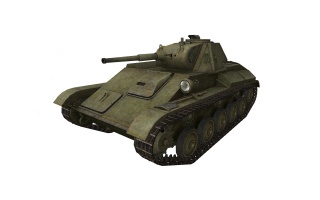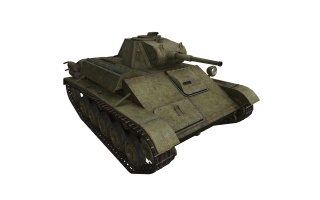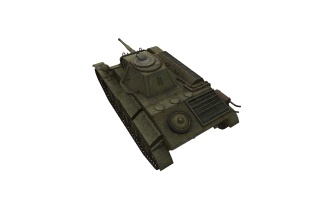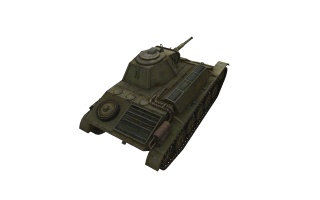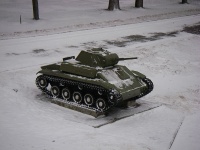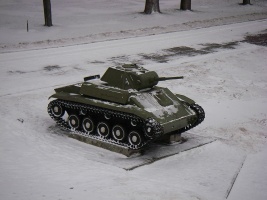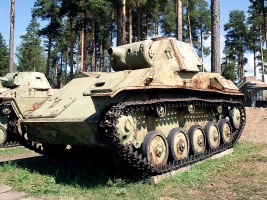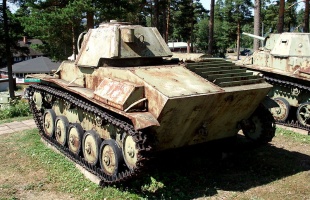T-70
T-70
Mouse over "
[Client Values; Actual values in
| 39,300 |
| 39082 HP Hit Points |
| 9.2/9.55.61/12.5 t Weight Limit |
- Commander (Gunner, Radio Operator, Loader)
- Driver
| 140170 hp Engine Power |
| 45/18 km/h Speed Limit |
| 4852 deg/s Traverse |
| 15.2230.3 hp/t Power/Wt Ratio |
| NoNo Pivot |
| // mm Hull Armor |
| 35/35/3535/35/35 mm Turret Armor |
AP/APCR/HE
AP/APCR/HE Shells |
14/800/14
35/1200/19 Shell Cost |
| 47/47/6255/55/65 HP Damage |
| 51/88/2375/110/23 mm Penetration |
|
25 r/m ▲
24 r/m Standard Gun ▲ Rate of Fire Standard Gun |
|
1175 ▲
Standard Gun
▼
Standard Gun
▲
1320 Standard Gun ▲
Standard Gun
▼
Standard Gun
▲ Damage Per Minute Standard Gun |
|
0.46 m ▲
0.37 m With 50% Crew: 0.585 m ▲ Accuracy With 50% Crew: 0.471 m |
| 2.3 s 2.3 s Aim time |
| 3640 deg/s Turret Traverse |
| 360° Gun Arc |
| -6°/+25°-4°/+19° Elevation Arc |
| 180160 rounds Ammo Capacity |
| 2020 % Chance of Fire |
| 300 m 310 m View Range |
| 325 m 525 m Signal Range |
III
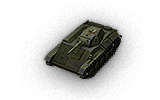
39300
The T-70 is a Soviet tier 3 light tank.
Developed in October and November 1941 at the Construction Bureau of the Gorky Automobile Plant under the supervision of N. A. Astrov. The vehicle came into service in January 1942, and it was mass-produced until October 1943, with a total of 8231 vehicles manufactured. Some vehicles were used until the end of the war.
The T-70 leads to the SU-76M.
Modules / Available Equipment and Consumables
Modules
| Tier | Engine | Engine Power (hp) |
Chance of Fire on Impact (%) |
Weight (kg) |
Price (
| |
|---|---|---|---|---|---|---|
| III | GAZ-203 | 140 | 20 | 550 | 3830 | |
| III | M-80 | 170 | 20 | 550 | 4130 |
| Tier | Suspension | Load Limit (т) |
Traverse Speed (gr/sec) |
Rmin | Weight (kg) |
Price (
| |
|---|---|---|---|---|---|---|---|
| II | T-70 | 9.5 | 48 | B/2 | 2400 | 600 | |
| III | T-70 enhanced | 12.5 | 52 | B/2 | 2400 | 1730 |
Compatible Equipment
Compatible Consumables
Player Opinion
Pros and Cons
Pros:
- Excellent penetration with top gun
- Quite fast, like other Soviet light tanks
- Good hull turn speed
- Frontal armor tends to be almost immune to automatic cannons at mid distance
- Low profile
Cons:
- Poor gun depression
- Engine is damaged quite often
- Paper side armor
- Critical hit in side usually end with dead commander and/or destroyed track
- Low number of crew
Performance
This tank (especially after obtaining the fearsome VT-42) is rather a frontline support tank. With your weak side armour you should keep away from fast tanks, which can (and will) flank you. Remember, with your speed you can flank the enemies position and spread serious damage among them. But be careful about the gun depression! The ones whom had played before with a tank with similar gun depression (like IS) shouldn't find themselves in a hard situation, unlike the one whom hadn't played such tank.
Playing aggressively is beneficial in tier III battles and some tier IV battles, when you can somewhat rely on your armour, especially the well-sloped frontal hull. Angling it a bit, not revealing a significant portion of your weak side armour improves the ability to withstand hostile fire. Also, extreme caution should be taken around vehicles equipped with howitzers, as the sides are easily penetrated by HE rounds and even a non-penetrating hit deals dreadful damage. In tier V battles, the horrible gun depression reduces your abilities to hide and engage the enemies, as you cannot play overly aggressively. Thus, choosing your sniping or scouting position carefully is of utmost importance.
Finally, though the armour is very good, at least frontally, relying too heavily on it may have dire consequences. In order to utilise the good top gun, staying alive should be the priority, as the high penetration gun may prove to be decisive in later stages of the game.
Early Research
- The 37 mm ZiS-19 gun carries over from the T-60. Its improved accuracy allows you to snipe early on.
- Improve the mobility by researching the T-70 enhanced chassis and the M-80 engine.
- Next, go for the improved T-70M turret to get the 45 mm VT-42 top gun.
- Last, research the 9RM radio. This long range radio is used on many Russian tanks in the higher tiers.
- If you played the SU-76 tank destroyer, you will find the engine and radio are already unlocked.
- The T-46 light tank also unlocks the top gun.
- Finally, research the T-80 tank and the SU-76 tank destroyer, if you haven't already.
Suggested Equipment
Gallery
Historical Info
Development history
The T-70 was armed with a 45-mm L/46 gun Model 38 with forty-five rounds carried, and a coaxial 7.62-mm DT machine gun. The tank was operated by a driver and a commander who loaded and fired the gun. Armour thickness on the turret front was 60 mm, hull front and sides: 45 mm, rear and turret sides: 35 mm, roof and bottom: 10 mm. By 1942, light tanks were considered inadequate by the Red Army, unable to keep up with the T-34 medium tank and unable to penetrate the armour of most German tanks, but they could be produced by small factories which were unable to handle the large components of medium and heavy tanks. The T-70 was an attempt to remedy some of the shortcomings of the T-60 scout tank, which had very poor cross-country mobility, thin armour, and an inadequate 20-mm gun. It also replaced the very short production run of the T-50 light infantry tank, which was more sophisticated, but also much too complicated and expensive to produce. The T-70 was designed by Nicholas Astrov's design team at Factory No. 38 in Kirov. The first batch of T-70s were built with a GAZ-202 automotive engine on each side of the hull, one driving each track. This arrangement was seen to be a serious problem, even before the first tanks were issued. It was quickly redesigned as the T-70M (although it continued to be referred to as just T-70), with the engines in-line on the right side of the tank and a normal transmission and differential. The conical turret was replaced by one more easily welded out of plate armour, and moved to the left side of the hull. Curiously, even after the T-70's production line was redesigned, SU-76 self-propelled guns started to be built with the same unsatisfactory unsynchronized two-engine layout, and all of them were later recalled for factory rebuilding as SU-76Ms. T-70s were put into production in March 1942 at Zavod No. 37, and along with T-60 production at GAZ and Zavod No. 38. They completely replaced T-60 production in September 1942, although that tank remained in use until the end of the war. Production ended in October 1943, with 8,226 vehicles completed. In April 1942, the conical turrets on early-production machines were replaced with new welded turrets. The end of the T-70's production run was built with two 85-hp GAZ-203 engines, a Mark 4 commander's periscope replacing a vision slit, and other improvements.The T-70 remained in service until 1948.
Limitations
The one-man turret of the Soviet light tanks made co-ordinating a tank platoon nearly impossible, because the commanders were kept busy acquiring targets, loading and firing the main gun and machine gun, and commanding their drivers. The infantry tank role was already considered obsolete. The SU-76 self-propelled gun was better suited for infantry support, its 76.2-mm gun capable of firing a larger high explosive shell. Industrial resources could be redirected from light tanks to building SU-76s. In an attempt to compensate, the T-80 light tank was designed, a more robust version of the T-70 with a two-man turret. But there was enough lend-lease equipment available to fulfill the reconnaissance role of the light tanks, and armoured cars were better suited for light scouting and liaison. All light tank production was cancelled in October 1943, after only about 120 T-80s were built. No further light tanks would be built during the war.
In November 1943 Red Army tank units were reorganized: light tanks were replaced by the T-34 and new T-34-85, which started production the following month. Light tanks continued to be used in self-propelled artillery and some other units. The Soviets did start development work on an amphibious light tank in 1945, resulting in the post-war PT-76, introduced in 1954.












